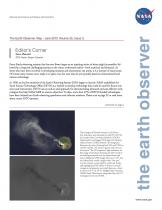



Recent Imagery
You will be directed to the NASA Visible Earth webpage when you select Images by Mission below, or click on the images at right that are randomly generated to represent four out of all possible topics.
The Earth Observer has a new look! Visit the NEW Earth Observer website.
The Earth Observer: May - Jun, 2013
In This Issue
Click title below to view page
- Editor’s Corner Front Cover
- Feature Articles
- Transitioning NASA Earth-observing Satellite Data to the Operational Weather Community4
- NASA Intensifies Hurricane Studies with CYGNSS12
- ESTO: Benefiting Earth Science through Technology 22
- Meeting/Workshop Summaries
- 2012 CLARREO Science Definition Team Meeting Summary30
- SMAP Calibration/Validation Workshop 32
- HyspIRI Science and Application Workshop Summary38
- In The News
- First Light for ISERV Pathfinder, Space Station's Newest 'Eye' on Earth40
- 2013 Wintertime Arctic Sea Ice Maximum Fifth Lowest on Record42
- Regular Features
- NASA Earth Science in the News 44
- NASA Science Mission Directorate – Science Education and Public Outreach Update 46
- Science Calendars 47
Editor's Corner
Steve Platnick, EOS Senior Project Scientist
Every Earth-observing mission that has ever flown began as an inspiring vision of what might be possible, followed by a long and challenging journey as the vision confronted reality—both technical and financial. As those who have been involved in developing missions and instruments can attest, it is a journey of many years. Of course some visions never make it to space, but the ones that do are typically based on demonstrated and mature technology.
In 1998, as the first missions of the Earth Observing System (EOS) began to launch, NASA established the Earth Science Technology Office (ESTO) as a testbed to develop technology that could be used for future missions and instruments. ESTO uses an end-to-end approach for demonstrating advanced and cost-effective technologies that help NASA fulfill its science objectives. To date, more than 37% of ESTO-funded technologies have been...
Read more...

